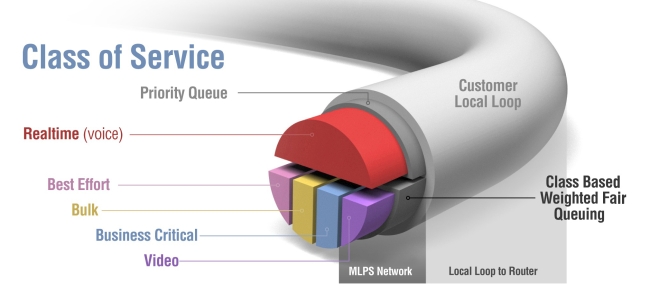Sobre o Curso Implementing Cisco Quality of Service (QOS)
Carga horária: 40 horas (5 dias)
Descrição do Curso QOS (em inglês)
Course Prerequisites
The knowledge and skills that a learner must have before attending this course are as follows: Interconnecting Cisco Networking Devices, Part 1 and 2 (ICND1 and ICND2
Course Description
Implementing Cisco Quality of Service (QoS) provides learners with in-depth knowledge of quality of service (QoS) requirements; conceptual models such as Best-Effort, Integrated Services (IntServ), and Differentiated Services (DiffServ); and the implementation of QoS on Cisco IOS platforms. The curriculum covers the theory of QoS, design issues, and configuration of various QoS mechanisms to facilitate the creation of effective QoS administrative policies. Case studies and lab activities included in the course help learners apply the concepts that are mastered in individual modules to real-life scenarios. The course also gives learners design and usage rules for various advanced QoS features and for the integration of QoS with underlying Layer 2 QoS mechanisms, allowing the learners to design and implement efficient, optimal, and trouble-free multiservice networks.
Course Objectives
Upon completing this course, you will be able to meet these objectives:
- You will be able to identify, describe, and correctly implement the appropriate QoS mechanisms required to create an effective administrative policy providing QoS
Job Roles
- Pre- and post-sales technical engineers responsible for designing, implementing, or troubleshooting networks
- Network architects responsible for designing multiservice networks to carry voice, video, and data traffic in enterprise or service provider environments
Faça seu treinamento com os melhores
Pagamentos no PagSeguro com segurança e flexibilidade em até 12 vezes
Ementa do Curso
- Module 1: Introduction to QoS
- Lesson 1-1: Review Converged Networks
- Lesson 1-2: Understand QoS
- Lesson 1-3: Describe Best-Effort and Integrated Services Models
- Lesson 1-4: Describe the Differentiated Services Model
- Lesson 1-5: Module Summary
- Lesson 1-6: Module Self-Check
- Module 2: Implement and Monitor QoS
- Lesson 2-1: MQC Introduction
- Lesson 2-2: Monitor QoS
- Lesson 2-3: Define Campus AutoQoS
- Lesson 2-4: Define WAN AutoQoS
- Lesson 2-5: Module Summary
- Lesson 2-6: Module Self-Check
- Module 3: Classification and Marking
- Lesson 3-1: Classification and Marking Overview
- Lesson 3-2: MQC for Classification and Marking
- Lesson 3-3: NBAR for Classification
- Lesson 3-4: Use of QoS Preclassify
- Lesson 3-5: Campus Classification and Marking
- Lesson 3-6: Module Summary
- Lesson 3-7: Module Self-Check
- Module 4: Congestion Management
- Lesson 4-1: Queuing Introduction
- Lesson 4-2: Configure WFQ
- Lesson 4-3: Configure CBWFQ and LLQ
- Lesson 4-4: Configure Campus Congestion Management
- Lesson 4-5: Module Summary
- Lesson 4-6: Module Self-Check
- Module 5: Congestion Avoidance
- Lesson 5-1: Congestion Avoidance Introduction
- Lesson 5-2: Configure Class-Based WRED
- Lesson 5-3: Configure ECN
- Lesson 5-4: Describe Campus-Based Congestion Avoidance
- Lesson 5-5: Module Summary
- Lesson 5-6: Module Self-Check
- Module 6: Traffic Policing and Shaping
- Lesson 6-1: Traffic Policing and Shaping Overview
- Lesson 6-2: Configure Class-Based Policing
- Lesson 6-3: Campus Policing
- Lesson 6-4: Configure Class-Based Shaping
- Lesson 6-5: Configure Class-Based Shaping on Frame Relay Interfaces
- Lesson 6-6: Configure Frame Relay Voice-Adaptive Traffic Shaping and Fragmentation
- Lesson 6-7: Module Summary
- Lesson 6-8: Module Self-Check
- Module 7: Link Efficiency Mechanisms
- Lesson 7-1: Link Efficiency Mechanisms Overview
- Lesson 7-2: Configure Class-Based Header Compression
- Lesson 7-3: Configure LFI
- Lesson 7-4: Module Summary
- Lesson 7-5: Module Self-Check
- Module 8: Deploying End-to-End QoS
- Lesson 8-1: Apply Best Practices for QoS Policy Design
- Lesson 8-2: End-to-End QoS Deployments
- Lesson 8-3: Module Summary
- Lesson 8-4: Module Self-Check
Laboratórios e Atividades Práticas
O curso é repleto de atividades práticas em laboratórios providos pela Cisco, o que torna a experiência de aprendizado bastante proveitosa!
- Case Study 1-1: QoS Mechanisms
- Lab 2-1: IP SLA Setup and QoS Baseline Measurement
- Lab 2-2: Configuring QoS with Cisco AutoQoS
- Case Study 3-1: Classification and Marking
- Lab 3-2: Classification and Marking Using MQC
- Lab 3-3: Using NBAR for Classification
- Lab 3-4: Configuring QoS Preclassify
- Lab 3-5: Campus Classification and Marking Using MQC
- Lab 4-1: Configuring Fair Queuing
- Lab 4-2: Configuring LLQ-CBWFQ
- Lab 4-3: Configuring Campus-Based Queuing Mechanisms
- Case Study 5-1: WRED Traffic Profiles
- Lab 5-2: Configuring DSCP-Based WRED
- Lab 5-3: Configuring WTD Thresholds
- Lab 6-1: Configuring Class-Based Policing
- Lab 6-2: Configuring Class-Based Shaping
- Lab 7-1: Configuring Class-Based Header Compression
- Lab 7-2: Configuring LFI
- Lab 8-1: Mapping Enterprise QoS Policy to the Service Provider Policy
Conheça mais sobre a nossa visão sobre as certificações da Cisco aqui!
Valores do Curso
- Reais (BRL): R$ 12.800,00
- Cisco Learning Credits (CLC): 32
OBS: preços válidos para treinamentos presenciais na cidade do Rio de Janeiro ou para treinamentos VILT (Online/WebEx).


Próximos Treinamentos Implementing Cisco Quality of Service (QOS) 2.5
abril 2024
Sem Treinamentos / Eventos
maio 2024
Sem Treinamentos / Eventos

